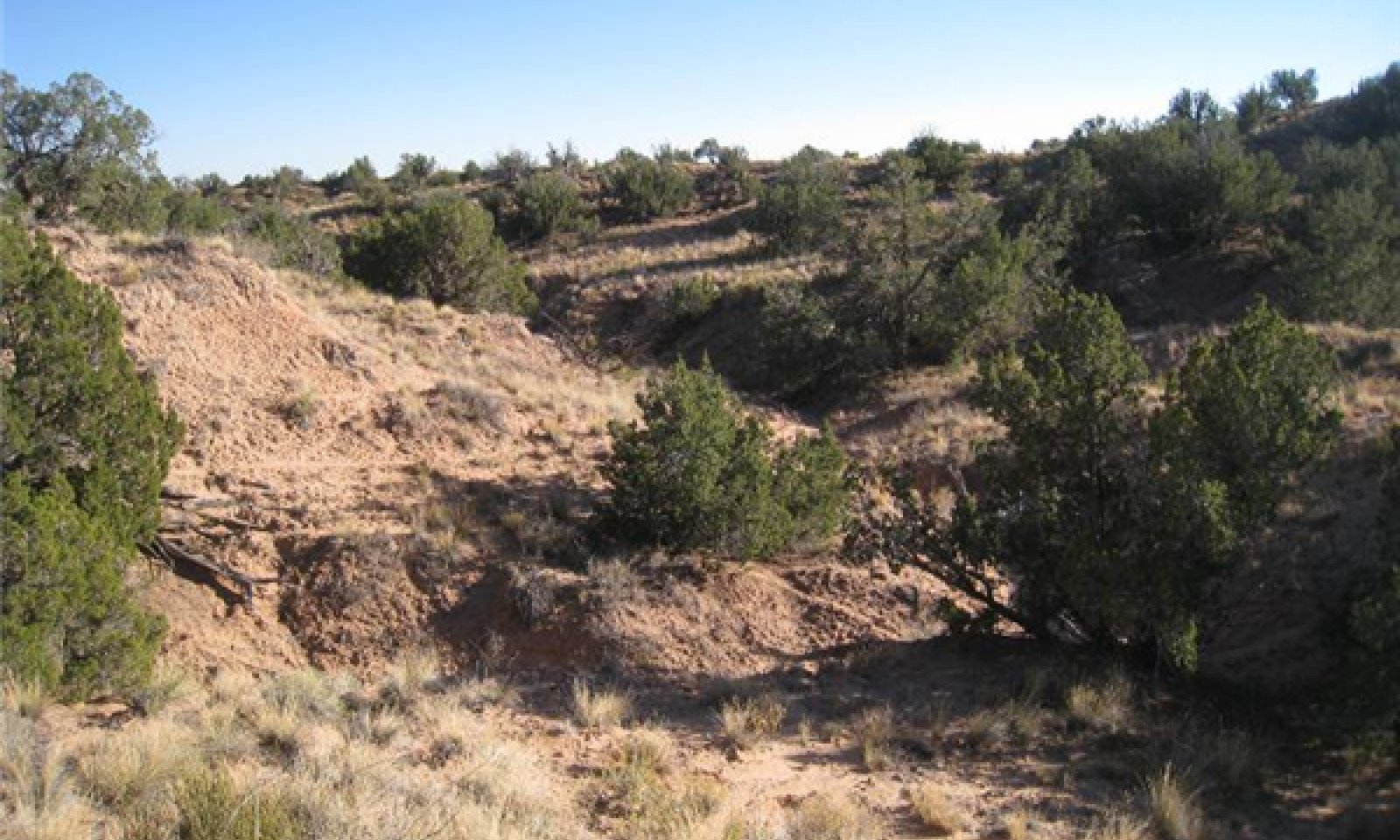

Natural Resources
Conservation Service
Ecological site R035XC377AZ
Sandy Slopes 10-14" p.z.
Accessed: 12/22/2024
General information
Provisional. A provisional ecological site description has undergone quality control and quality assurance review. It contains a working state and transition model and enough information to identify the ecological site.
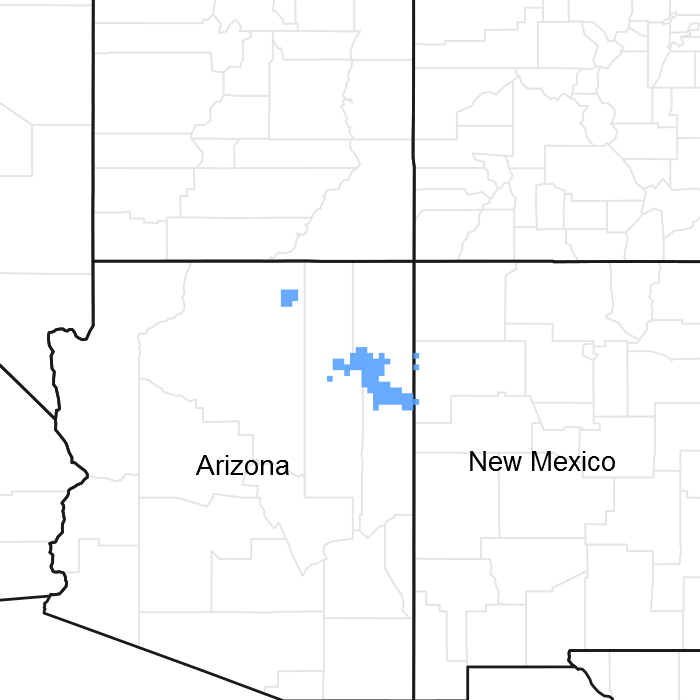
Figure 1. Mapped extent
Areas shown in blue indicate the maximum mapped extent of this ecological site. Other ecological sites likely occur within the highlighted areas. It is also possible for this ecological site to occur outside of highlighted areas if detailed soil survey has not been completed or recently updated.
MLRA notes
Major Land Resource Area (MLRA): 035X–Colorado Plateau
This ecological site is found in Common Resource Area 35.3 – the Colorado Plateau Sagebrush – Grasslands.
The Common Resource Area occurs within the Colorado Plateau Physiographic Province. It is characterized by a sequence of flat to gently dipping sedimentary rocks eroded into plateaus, valleys and deep canyons. Elevations range from 4800 to 6700 feet and precipitation averages 10 to 14 inches. The elevation range is lower (about 4500 to 6000 ) on the western side of the Colorado Plateau along the Grand Canyon, and moves up about 500 to 800 feet higher on the eastern side in the areas of the Navajo and Hopi Indian Reservations due to rain shadow effects from the Kaibab Plateau and Mogollon Rim. Common vegetation in this region includes Wyoming big sagebrush, Utah juniper, Colorado pinyon - cliffrose, Mormon tea, fourwing saltbush, blackbrush Indian ricegrass, needle and thread, western wheatgrass Galleta, black grama, blue grama, and sand dropseed. Sedimentary rock classes dominate the plateau with volcanic fields occurring for the most part near its margin. The soil temperature regime is mesic and the soil moisture regime is ustic aridic.
Similar sites
| R035XC315AZ |
Sandy Upland 10-14" p.z. |
|---|---|
| F035XC323AZ |
Sandy Upland 10-14" p.z. (JUOS) |
Table 1. Dominant plant species
| Tree |
(1) Juniperus |
|---|---|
| Shrub |
(1) Artemisia tridentata ssp. wyomingensis |
| Herbaceous |
(1) Bouteloua gracilis |
Physiographic features
This ecological site occurs on stabilized dunes with steep slopes. The overall slope of the site is 15 to 45 percent, but may include flatter or steeper spots. This ecological site is found on hillslopes, edges of plateaus and valley sides with soils that are deep to very deep to any plant root restricting layer. The surface texture of the soil is generally loamy sand, loamy fine sand or fine sand. Subsurface horizons are generally fine sand or sand.
Table 2. Representative physiographic features
| Landforms |
(1)
Hill
(2) Escarpment (3) Valley side |
|---|---|
| Flooding frequency | None |
| Ponding frequency | None |
| Elevation | 1,463 – 2,042 m |
| Slope | 15 – 45% |
| Aspect | N, S, W |
Climatic features
Winter summer moisture ratios range from 70:30 to 60:40. Late spring is usually the driest period, and early fall moisture can be sporadic. Summer rains fall from June through September; moisture originates in the Gulf of Mexico and creates convective, usually brief, intense thunderstorms. Cool season moisture from October through May tends to be frontal; it originates in the Pacific and the Gulf of California and falls in widespread storms with longer duration and lower intensity. Precipitation generally comes as snow from December through February. Accumulations above 12 inches are not common but can occur. Snow usually lasts for 3-4 days, but can persist much longer. Summer daytime temperatures are commonly 95 - 100 F and on occasion exceed 105 F. Winter air temperatures can regularly go below 10 F and have been recorded below - 20 F.
Table 3. Representative climatic features
| Frost-free period (average) | 168 days |
|---|---|
| Freeze-free period (average) | 193 days |
| Precipitation total (average) | 356 mm |
Figure 2. Monthly precipitation range
Figure 3. Monthly average minimum and maximum temperature
Influencing water features
The soil moisture on this ecological site comes from precipitation. The site does not benefit significantly from run-on moisture. The sandy surface texture of the soil allows the site to capture the majority of both gentle winter storms and intense summer thunderstorms with little runoff.
Soil features
The soils associated with this ecological site are deep to very deep to any plant root restricting layer. The surface texture of the soil is generally fine sand, loamy sand to loamy fine sand. Subsurface horizons are generally sand, fine sand, loamy sand and loamy fine sand. Parent material is eolian material and alluvium derived mainly from sandstone. The soil ranges from slightly to moderately alkaline (pH 7.4 to 8.4). The permeability is moderately rapid to rapid and the soil profile can absorb all the moisture the climate can supply. The available water capacity is very low to low. Wind erosion is a severe problem if the vegetative cover is lost. Soil moisture regime is ustic aridic. Soil temperature regime is mesic.
Typical taxonomic units on this site include:
SSA 711 Navajo Mountain Area MU's 35 Pinavetes and 39 Mido;
SSA 713 Chinle Area MU 39 Mido;
SSA 715 Fort Defiance Area AZ/NM MU's 82 & 84 Pinavettes family.
Table 4. Representative soil features
| Parent material |
(1)
Eolian deposits
–
sandstone
|
|---|---|
| Surface texture |
(1) Loamy sand (2) Loamy fine sand (3) Fine sand |
| Family particle size |
(1) Sandy |
| Drainage class | Excessively drained |
| Permeability class | Moderately rapid to rapid |
| Soil depth | 152 – 203 cm |
| Surface fragment cover <=3" | 0 – 20% |
| Surface fragment cover >3" | 0 – 5% |
| Available water capacity (0-101.6cm) |
6.35 – 10.16 cm |
| Calcium carbonate equivalent (0-101.6cm) |
0 – 2% |
| Electrical conductivity (0-101.6cm) |
0 – 2 mmhos/cm |
| Sodium adsorption ratio (0-101.6cm) |
0 |
| Soil reaction (1:1 water) (0-101.6cm) |
7.4 – 8.4 |
Ecological dynamics
The plant communities found on an ecological site are naturally variable. Composition and production will vary with yearly conditions, location, aspect, and the natural variability of the soils. The historical climax plant community (HCPC) represents the natural potential of plant communities found on relict or relatively undisturbed sites. Other plant communities described here represent plant communities that are known to occur when the site is disturbed by factors such as grazing, fire, or drought.
Production data provided in this site description is standardized to air-dry weight at the end of the summer growing season. The plant communities described in this site description are based on near normal rainfall years.
NRCS uses a Similarity Index to compare existing plant communities to the plant communities described here. Similarity Index is determined by comparing the production and composition of a plant community to the production and composition of a plant community described in this site description. To determine Similarity Index, compare the production (air-dry weight) of each species to that shown in the plant community description. For each species, count no more than the maximum amount shown for the species, and for each group, count no more than the maximum shown for the group. Divide the resulting total by the total normal year production shown in the plant community description. If rainfall has been significantly above or below normal, use the total production shown for above or below normal years. If field data is not collected at the end of the summer growing season, then the field data must be corrected to the end of the year production before comparing it to the site description. The growth curve can be used as a guide for estimating production at the end of the summer growing season.
The State and Transition model shows the most common occurring plant communities likely to be encountered on this ecological site. This model may not show every possible plant community, but only those that are most prevalent and observed through field inventory. As more data is collected these plant communities may be revised, removed, and some added to reflect the ecological dynamics of this site.
State and transition model

Figure 4. STM - R035XC377AZ
More interactive model formats are also available.
View Interactive Models
More interactive model formats are also available.
View Interactive Models
Click on state and transition labels to scroll to the respective text
State 1 submodel, plant communities
State 2 submodel, plant communities
State 3 submodel, plant communities
State 1
Reference Plant Community
Community 1.1
Historic Climax Plant Community

Figure 5. Sandy Slopes 10-14" p.z.
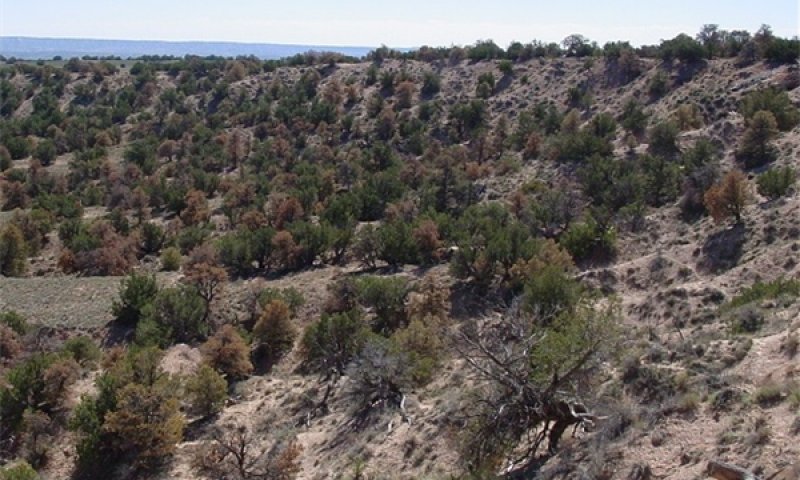
Figure 6. Sandy Slopes 10-14" p.z.
This site has a plant community made up of primarily short and midgrasses with a mixture of shrubs and minor amounts of forbs and scattered trees. Major grasses include blue grama, Indian ricegrass, sand dropseed, needle and thread and black grama. Major shrubs include Wyoming big sagebrush, Greene's rabbitbrush, fourwing saltbush and broom snakeweed and mormon tea. A light overstory (5-15% canopy) of juniper and pinyon pine is present on this site. Plants most likely to increase or invade when the site deteriorates are sandhill muhly, Fendler's threeawn, false-buffalo grass, galleta, rabbitbrush, broom snakeweed, dunebroom and juniper; annual forbs and grasses will invade.
Figure 7. Annual production by plant type (representative values) or group (midpoint values)
Table 5. Annual production by plant type
| Plant type | Low (kg/hectare) |
Representative value (kg/hectare) |
High (kg/hectare) |
|---|---|---|---|
| Grass/Grasslike | 202 | 308 | 404 |
| Shrub/Vine | 112 | 196 | 280 |
| Tree | 28 | 56 | 95 |
| Forb | 28 | 45 | 73 |
| Total | 370 | 605 | 852 |
Table 6. Soil surface cover
| Tree basal cover | 0-10% |
|---|---|
| Shrub/vine/liana basal cover | 1-5% |
| Grass/grasslike basal cover | 5-10% |
| Forb basal cover | 0-2% |
| Non-vascular plants | 0-1% |
| Biological crusts | 0-15% |
| Litter | 20-30% |
| Surface fragments >0.25" and <=3" | 0-10% |
| Surface fragments >3" | 0-10% |
| Bedrock | 0% |
| Water | 0% |
| Bare ground | 45-60% |
Table 7. Canopy structure (% cover)
| Height Above Ground (m) | Tree | Shrub/Vine | Grass/ Grasslike |
Forb |
|---|---|---|---|---|
| <0.15 | – | 1-10% | 5-10% | 0-2% |
| >0.15 <= 0.3 | – | 1-5% | 0-5% | – |
| >0.3 <= 0.6 | – | 0-1% | – | – |
| >0.6 <= 1.4 | – | – | – | – |
| >1.4 <= 4 | 5-10% | – | – | – |
| >4 <= 12 | 0-5% | – | – | – |
| >12 <= 24 | – | – | – | – |
| >24 <= 37 | – | – | – | – |
| >37 | – | – | – | – |
Figure 8. Plant community growth curve (percent production by month). AZ3501, 35.3 10-14" p.z. needle and thread. Growth starts in spring and extends into summer, plants may be green in the fall..
| Jan | Feb | Mar | Apr | May | Jun | Jul | Aug | Sep | Oct | Nov | Dec |
|---|---|---|---|---|---|---|---|---|---|---|---|
| J | F | M | A | M | J | J | A | S | O | N | D |
| 0 | 0 | 10 | 20 | 30 | 10 | 5 | 5 | 10 | 10 | 0 | 0 |
Figure 9. Plant community growth curve (percent production by month). AZ3505, 35.3 10-14" p.z. Indian ricegrass. Growth begins in spring, with semi-dormancy occurring during July through August. Plants will green up again in the fall..
| Jan | Feb | Mar | Apr | May | Jun | Jul | Aug | Sep | Oct | Nov | Dec |
|---|---|---|---|---|---|---|---|---|---|---|---|
| J | F | M | A | M | J | J | A | S | O | N | D |
| 0 | 0 | 10 | 20 | 25 | 20 | 5 | 5 | 10 | 5 | 0 | 0 |
Figure 10. Plant community growth curve (percent production by month). AZ3508, 35.3 10-14" p.z. Wyoming big sagebrush. Most growth occurs in spring and early summer. Stem elongation and seed set occur in the fall..
| Jan | Feb | Mar | Apr | May | Jun | Jul | Aug | Sep | Oct | Nov | Dec |
|---|---|---|---|---|---|---|---|---|---|---|---|
| J | F | M | A | M | J | J | A | S | O | N | D |
| 0 | 0 | 0 | 5 | 15 | 30 | 20 | 10 | 10 | 10 | 0 | 0 |
Figure 11. Plant community growth curve (percent production by month). AZ3531, 35.3 10-14" p.z. all sites. Growth begins in the spring and continues through the summer..
| Jan | Feb | Mar | Apr | May | Jun | Jul | Aug | Sep | Oct | Nov | Dec |
|---|---|---|---|---|---|---|---|---|---|---|---|
| J | F | M | A | M | J | J | A | S | O | N | D |
| 0 | 1 | 3 | 17 | 18 | 10 | 19 | 20 | 10 | 1 | 1 | 0 |
Figure 12. Plant community growth curve (percent production by month). AZ3567, 35.3 10-14" p.z. blue grama. Growth occurs mostly during the summer rainy season..
| Jan | Feb | Mar | Apr | May | Jun | Jul | Aug | Sep | Oct | Nov | Dec |
|---|---|---|---|---|---|---|---|---|---|---|---|
| J | F | M | A | M | J | J | A | S | O | N | D |
| 0 | 0 | 0 | 0 | 5 | 5 | 30 | 55 | 5 | 0 | 0 | 0 |
Community 1.2
Shrubland with Trees
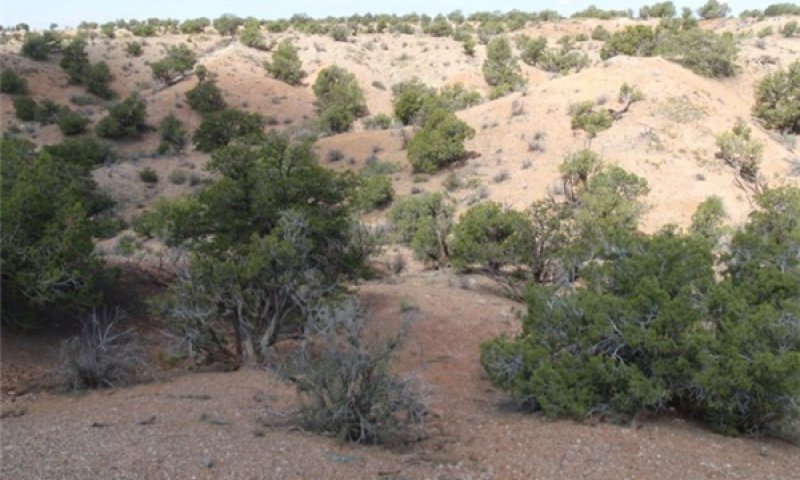
Figure 13. Shrubs and Trees
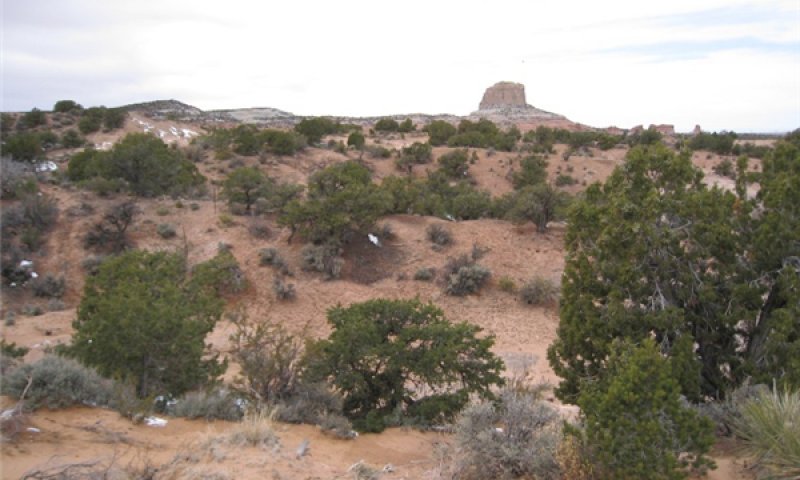
Figure 14. Shrub and Trees
This plant community is characterized by a decline of perennial cool season grasses and a increase of shrubs, especially half shrubs and succulents. Trees cover (up to 25% canopy) may also increase, especially on cooler aspects. Grasses expected to increase are blue grama, galleta, sand dropseed, sandhill muhly and threeawns. Common shrubs include snakeweed, rabbitbrush, mormon tea, cacti, antelope bitterbrush and dune broom.
Pathway 1.1a
Community 1.1 to 1.2


Unmanaged grazing, natural tree regeneration/lack of fire
Pathway 1.2a
Community 1.2 to 1.1


Prescribed grazing, insect infestation (beetle kill) and/or extensive woodcutting, followed by periods of favorable or return normal precipitation events.
State 2
Native/ Introduced Annuals
This state has native shrubs and grasses, but now has introduced non-native annuals in the plant community. This is a loss of biotic integrity and degradation of soil site stability. Severe droughts, unmanaged grazing and frequent soils surface disturbance has allow for the introduction and establishment of non-natives. During periods of above average precipitation annuals can produce moderate amounts of cover.
Community 2.1
Native Grass/Shrub with Introduced Annuals
Introduced exotic annual grasses and forbs are present in minor amounts in the plant community, but the amount and proportions of native plants is similar to that found in plant community 1.1, Reference Plant Community.
Community 2.2
Shrubs with Grasses/Trees with Introduced Annuals
This plant community has a mix of large and half-shrubs with scattered overstory of trees. Grasses cover is reduced and most grasses are found within the shrub or tree canopies. Introduced exotic annual grasses and forbs are present in moderate amounts (5-25%) in the plant community.
Pathway 2.1a
Community 2.1 to 2.2
Unmanaged grazing, natural tree regeneration/lack of fire
Pathway 2.2a
Community 2.2 to 2.1
Prescribed grazing, insect infestation (beetle kill) and/or extensive woodcutting, followed by periods of favorable or return normal precipitation events.
State 3
Disturbed Surface
This state is dominated by trees and shrubs with native and non-native annuals. Grasses are mostly absent or severly reduced. Bare ground patches are large and connected within the woody canopy. There are active signs of erosion and deposition.
Community 3.1
Woody Overstory with Disturbed Surface
This site is characterized by a overstory canopy dominated by Junipers and Pinyon Pine with a understory of annuals and scattered shrubs and succulents. Prolonged drought conditions along with improper grazing have reduced the perennial herbaceous ground cover and increased soil erosion. There is significant disturbances to the soil surface through rills and gullies. Gullies show signs of active headcutting and rills/water flow patterns are evident and connected. A return pathway for this plant community may existm but is not displayed in the state and transition model. The possibe return pathways to state 2 may take several years or decades to occur thru management and practices, but may not be feasible due to the need for significant inputs.
Transition T1A
State 1 to 2
Introduction of non-native annuals species creates an irreversible change in the plant community
Transition T1B
State 1 to 3
Continuous heavy grazing and/or continous soil surface distance, natural tree regeneration/lack of fire, Introduction of non-native annuals, reduced perennial cover.
Transition T2A
State 2 to 3
Continuous heavy grazing and/or continous soil surface distance, natural tree regeneration/lack of fire, loss of perennial cover.
Restoration pathway R2A
State 3 to 2
Brush treatment to control woody species, reseeding or seed source for grass recovery, Prescribed grazing or No grazing. This pathway may not be feasible on a large scale due to significant inputs required.
Additional community tables
Table 8. Community 1.1 plant community composition
| Group | Common name | Symbol | Scientific name | Annual production (kg/hectare) | Foliar cover (%) | |
|---|---|---|---|---|---|---|
|
Grass/Grasslike
|
||||||
| 0 | Cool Season Grasses | 112–224 | ||||
| Indian ricegrass | ACHY | Achnatherum hymenoides | 84–140 | – | ||
| needle and thread | HECO26 | Hesperostipa comata | 56–112 | – | ||
| squirreltail | ELEL5 | Elymus elymoides | 28–56 | – | ||
| muttongrass | POFE | Poa fendleriana | 0–28 | – | ||
| 1 | Warm Season Grasses | 90–179 | ||||
| blue grama | BOGR2 | Bouteloua gracilis | 56–112 | – | ||
| sandhill muhly | MUPU2 | Muhlenbergia pungens | 6–34 | – | ||
| James' galleta | PLJA | Pleuraphis jamesii | 6–34 | – | ||
| black grama | BOER4 | Bouteloua eriopoda | 6–34 | – | ||
| spike dropseed | SPCO4 | Sporobolus contractus | 0–22 | – | ||
| sand dropseed | SPCR | Sporobolus cryptandrus | 0–22 | – | ||
| floating bur-reed | SPFL | Sparganium fluctuans | 0–22 | – | ||
| mesa dropseed | SPFL2 | Sporobolus flexuosus | 0–22 | – | ||
|
Forb
|
||||||
| 2 | All Forbs | 28–73 | ||||
| James' galleta | PLJA | Pleuraphis jamesii | 7–62 | – | ||
| Forb, perennial | 2FP | Forb, perennial | 0–22 | – | ||
| Forb, annual | 2FA | Forb, annual | 0–17 | – | ||
| beardtongue | PENST | Penstemon | 0–11 | – | ||
| globemallow | SPHAE | Sphaeralcea | 0–11 | – | ||
| Wyoming Indian paintbrush | CALI4 | Castilleja linariifolia | 0–11 | – | ||
| rose heath | CHER2 | Chaetopappa ericoides | 0–11 | – | ||
| cryptantha | CRYPT | Cryptantha | 0–11 | – | ||
| winged buckwheat | ERAL4 | Eriogonum alatum | 0–11 | – | ||
| sand verbena | ABRON | Abronia | 0–7 | – | ||
| locoweed | OXYTR | Oxytropis | 0–6 | – | ||
|
Shrub/Vine
|
||||||
| 7 | Common Shrubs | 78–202 | ||||
| Wyoming big sagebrush | ARTRW8 | Artemisia tridentata ssp. wyomingensis | 11–56 | – | ||
| fourwing saltbush | ATCA2 | Atriplex canescens | 11–56 | – | ||
| jointfir | EPHED | Ephedra | 6–34 | – | ||
| winterfat | KRLA2 | Krascheninnikovia lanata | 6–34 | – | ||
| antelope bitterbrush | PUTR2 | Purshia tridentata | 6–34 | – | ||
| sand sagebrush | ARFI2 | Artemisia filifolia | 6–34 | – | ||
| 8 | Other Shrubs | 45–78 | ||||
| rubber rabbitbrush | ERNAB2 | Ericameria nauseosa ssp. nauseosa var. bigelovii | 0–17 | – | ||
| broom snakeweed | GUSA2 | Gutierrezia sarothrae | 0–17 | – | ||
| Greene's rabbitbrush | CHGR6 | Chrysothamnus greenei | 0–17 | – | ||
| yellow rabbitbrush | CHVI8 | Chrysothamnus viscidiflorus | 0–17 | – | ||
| prairie sagewort | ARFR4 | Artemisia frigida | 0–11 | – | ||
| common dunebroom | PAFI4 | Parryella filifolia | 0–11 | – | ||
| frosted mint | POIN3 | Poliomintha incana | 0–11 | – | ||
| narrowleaf yucca | YUAN2 | Yucca angustissima | 0–6 | – | ||
| plains pricklypear | OPPO | Opuntia polyacantha | 0–6 | – | ||
| Whipple cholla | CYWH | Cylindropuntia whipplei | 0–6 | – | ||
| sand buckwheat | ERLE9 | Eriogonum leptocladon | 0–6 | – | ||
| Subshrub (<.5m) | 2SUBS | Subshrub (<.5m) | 0–6 | – | ||
|
Tree
|
||||||
| 14 | Trees | 28–95 | ||||
| juniper | JUNIP | Juniperus | 17–56 | – | ||
| twoneedle pinyon | PIED | Pinus edulis | 11–39 | – | ||
Interpretations
Animal community
This site has limited suitability for grazing by stocker cattle, horses, and sheep during spring, summer and fall with a good variety of plants. In areas of steep slopes, livestock grazing is severely restricted and proper grazing distribution is often impossible to attain. Heavy use may occur in areas where access areas are frequented by livestock.
This site provides a great deal of habitat diversity because of the variety of food, topography, exposures and cover for wildlife species. Water can be scarce in natural springs or pockets.
Wildlife found on this site include golden eagles, red-tail hawks, badgers, porcupines, ground squirrels, snakes, blacktail jackrabbits, lizards and mule deer.
Recreational uses
Site is typically on edges of escarpments, terraces, valley sides and hills with sandstone parent material. It produces a mix of grasses, shrubs, forbs and a light overstory of trees which can be very picturesque.
Winters are cold, however, relatively mild spring, fall and summer months are attractive to recreationists.
Activities include hunting, cross-country riding, photography, hiking, and wildlife observation
Supporting information
Other references
Updates and revisions for this ESD were conducted as part of a 2007-2012 Interagency Technical Assistance Agreement between the Bureau of Indian Affairs–Navajo Region and the NRCS-Arizona.
Contributors
Ken Gishi
Larry D. Ellicott
Rangeland health reference sheet
Interpreting Indicators of Rangeland Health is a qualitative assessment protocol used to determine ecosystem condition based on benchmark characteristics described in the Reference Sheet. A suite of 17 (or more) indicators are typically considered in an assessment. The ecological site(s) representative of an assessment location must be known prior to applying the protocol and must be verified based on soils and climate. Current plant community cannot be used to identify the ecological site.
| Author(s)/participant(s) | Ken Gishi |
|---|---|
| Contact for lead author | State Rangeland Management Specialist, NRCS-Arizona State Office, Phoenix, AZ |
| Date | 10/09/2008 |
| Approved by | Steve Barker |
| Approval date | |
| Composition (Indicators 10 and 12) based on | Annual Production |
Indicators
-
Number and extent of rills:
A few rills may form on steepest slopes. -
Presence of water flow patterns:
Somewhat common, probably cover no more than 15% of the area; mostly discontinuous, usually less than 8 feet in length. On steepest slopes water flow patterns may be continuous and as long as 12 feet in length. -
Number and height of erosional pedestals or terracettes:
Pedestals and terracettes may be common, especially during a drought, due to high wind erosion hazard of the soils and steepness of soils. -
Bare ground from Ecological Site Description or other studies (rock, litter, lichen, moss, plant canopy are not bare ground):
Bare ground averages about 50%. Drought may cause an increase in bare ground. -
Number of gullies and erosion associated with gullies:
Uncommon, but occasional gullies will form in natural drainages on steeper slopes due to reduced plant cover and lack of rock fragments. -
Extent of wind scoured, blowouts and/or depositional areas:
Some wind scoured areas and depositional areas may occur, especially on edges of escarpments and during droughts, due to high wind erosion hazard of the soil. High wind erosion hazard occurs on soils with surface textures of loamy sand, fine sand and sand. -
Amount of litter movement (describe size and distance expected to travel):
Herbaceous and fine woody litter will be transported primarily by wind and in water flow pathways. Coarse woody litter will remain under tree and shrub canopies. -
Soil surface (top few mm) resistance to erosion (stability values are averages - most sites will show a range of values):
Soil surface texture range from loamy sand to sand. Coarse rock fragments range from 0 to 15 percent and help protect the site. Soil on this site will often have a thin crust (biological or physical) providing some protection against erosion. Soil aggregate stability ratings should average 3 under plant canopies and 2 in the interspaces. -
Soil surface structure and SOM content (include type of structure and A-horizon color and thickness):
Soil surface structure is single grain; loose, but some soil surfaces are weakly granular. Surface textures are loamy sand, loamy fine sand and fine sand with thickness ranging from 2-3 inches. Surface color is light brown (7.5YR 6/4) and subsurface is pink (7.5YR 7/4), however color can be variable with hues of 5YR to 7.5YR. -
Effect of community phase composition (relative proportion of different functional groups) and spatial distribution on infiltration and runoff:
This site is characterized by scattered plants with a light overstory of trees, generally with less than 15% canopy cover by trees. The plant community consists of about 50% grasses, 35% shrubs, 10% trees and succulents with about 5% forbs. Basal cover range from 5-15% (Grasses>Shrubs>forbs>trees). -
Presence and thickness of compaction layer (usually none; describe soil profile features which may be mistaken for compaction on this site):
None -
Functional/Structural Groups (list in order of descending dominance by above-ground annual-production or live foliar cover using symbols: >>, >, = to indicate much greater than, greater than, and equal to):
Dominant:
Cool season bunch grasses > warm season grasses > shrubsSub-dominant:
forbs >= trees > Opuntia and other succulentsOther:
Additional:
-
Amount of plant mortality and decadence (include which functional groups are expected to show mortality or decadence):
All plant functional groups are adapted to survival in all but the most severe droughts. Sever winter droughts affect shrubs and trees the most. Severe summer droughts affect grasses the most. -
Average percent litter cover (%) and depth ( in):
Litter is a mix of fine herbaceous litter and coarse woody litter. Litter cover and depth will be highest beneath shrubs and trees. Litter cover and depth is lowest in the plant interspaces. -
Expected annual annual-production (this is TOTAL above-ground annual-production, not just forage annual-production):
Average annual production on this site is expected to be 500 to 600 lbs/ac in a year of average annual production. -
Potential invasive (including noxious) species (native and non-native). List species which BOTH characterize degraded states and have the potential to become a dominant or co-dominant species on the ecological site if their future establishment and growth is not actively controlled by management interventions. Species that become dominant for only one to several years (e.g., short-term response to drought or wildfire) are not invasive plants. Note that unlike other indicators, we are describing what is NOT expected in the reference state for the ecological site:
Broom snakeweed, rabbitbrush, yucca, Mormon tea, dune broom, and sandhill muhly occur naturally on this site, but can increase with disturbance. Plants that have the potential to invade this site are cheatgrass, ripgut brome and Russian thistle. Both juniper and pinyon pine have the potential to increase and invade a site with overstory canopies reaching up to 30% in the absence of fires and favorable climatic conditions for tree regeneration. -
Perennial plant reproductive capability:
All plants native to this site are adapted to the climate and are capable of producing seeds, stolons and rhizomes except during the most severe droughts.
Print Options
Sections
Font
Other
The Ecosystem Dynamics Interpretive Tool is an information system framework developed by the USDA-ARS Jornada Experimental Range, USDA Natural Resources Conservation Service, and New Mexico State University.
Click on box and path labels to scroll to the respective text.